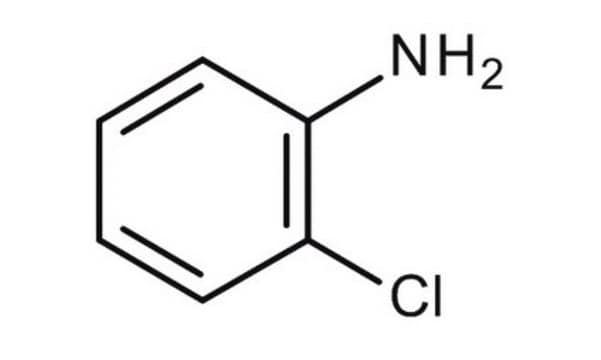C22415
4-Chloroaniline
98%
Synonyme(s) :
1-Amino-4-chlorobenzene, 4-Chlorophenylamine, p-Chloroaniline
About This Item
Produits recommandés
Densité de vapeur
4.4 (vs air)
Niveau de qualité
Pression de vapeur
0.15 mmHg ( 25 °C)
Pureté
98%
Forme
chips
crystals or chunks
Point d'ébullition
232 °C (lit.)
Pf
67-70 °C (lit.)
Chaîne SMILES
Nc1ccc(Cl)cc1
InChI
1S/C6H6ClN/c7-5-1-3-6(8)4-2-5/h1-4H,8H2
Clé InChI
QSNSCYSYFYORTR-UHFFFAOYSA-N
Vous recherchez des produits similaires ? Visite Guide de comparaison des produits
Application
- Allylation in the presence of ultrasonication to form N-allyl-4-chloroaniline, a precursor for bioactive compounds containing indole and dihydroindole nucleus.
- Povarov reaction with cyclopentadiene to form C-2 aliphatic substituted tetrahydroquinolines.
- Mannich reaction with aldehydes and cyclic ketones to form β-amino carbonyl compounds.
- Nitration to form 4-chloro-3-nitroaniline in the presence of guanidinium nitrate.
Mention d'avertissement
Danger
Mentions de danger
Conseils de prudence
Classification des risques
Acute Tox. 3 Dermal - Acute Tox. 3 Inhalation - Acute Tox. 3 Oral - Aquatic Acute 1 - Aquatic Chronic 1 - Carc. 1B - Skin Sens. 1
Code de la classe de stockage
6.1A - Combustible acute toxic Cat. 1 and 2 / very toxic hazardous materials
Classe de danger pour l'eau (WGK)
WGK 3
Point d'éclair (°F)
248.0 °F - closed cup
Point d'éclair (°C)
120.0 °C - closed cup
Équipement de protection individuelle
Eyeshields, Faceshields, Gloves, type P3 (EN 143) respirator cartridges
Certificats d'analyse (COA)
Recherchez un Certificats d'analyse (COA) en saisissant le numéro de lot du produit. Les numéros de lot figurent sur l'étiquette du produit après les mots "Lot" ou "Batch".
Déjà en possession de ce produit ?
Retrouvez la documentation relative aux produits que vous avez récemment achetés dans la Bibliothèque de documents.
Les clients ont également consulté
Notre équipe de scientifiques dispose d'une expérience dans tous les secteurs de la recherche, notamment en sciences de la vie, science des matériaux, synthèse chimique, chromatographie, analyse et dans de nombreux autres domaines..
Contacter notre Service technique














